|
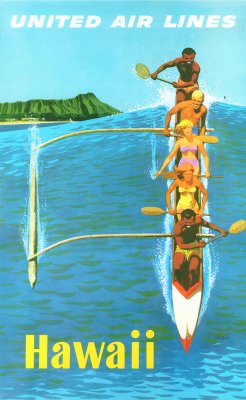
|
Big
Island
Day Two - The Trip to the
Big Island Volcanoes
Story written by Rick Archer
|
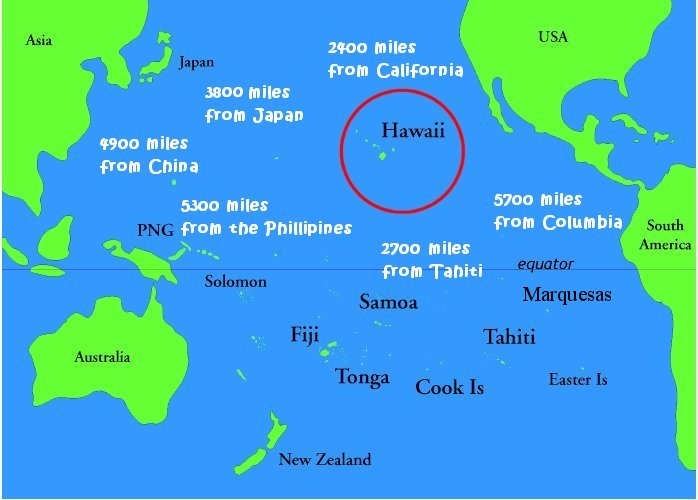 |
Throughout this trip, I was fascinated by so many
aspects of Hawaii.
One question I was curious about was how
the islands were discovered in the first place. A quick glance
at the map reveals a vast amount of water between Hawaii and the
nearest land.
Hawaii is right in the middle of NOWHERE!
So who discovered Hawaii? And how on earth did they
discover the islands in the first place?
Think about Columbus and how much fear was attached to his
exploration. Columbus traveled 4,900 miles using technology
from 1492.
Hawaii was discovered 1,000 years earlier using
sailboats!
|
Around 300-500 AD, Polynesians from the South Pacific,
probably the Marquesas Islands (900 miles
northeast of
Tahiti), found the Hawaiian Islands in
double-hulled voyaging canoes.
Who in
their right mind ventures in ancient canoes 3,000 miles into the
dangerous waters of the vast Pacific Ocean without a good reason? One good storm and
those guys were toast. Why would these brave sailors
venture 3,000 miles into the middle of nowhere? And how did they find the islands? Did they
stumble upon the islands by luck?
Furthermore how many provisions can you carry on those canoes?
It took Columbus two months to cross the Atlantic. These
Polynesian sailors had no way of knowing when their journey would
end. Where would they get fresh water?
On the surface, their exploration seemed like a suicide
mission.
|
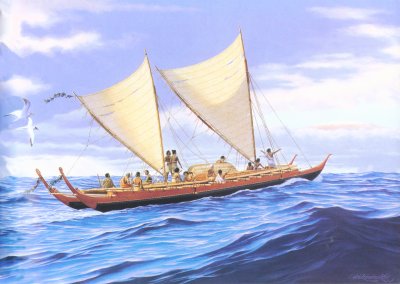 |
 |
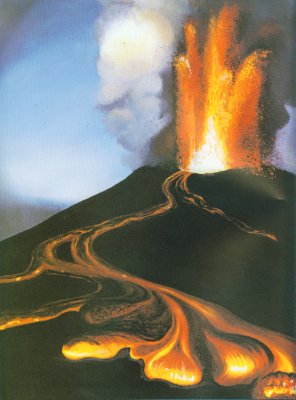 |
One day when Marla and I were at
Haleakula in Maui, I listened to a park ranger give a talk
about the ancestors. Afterwards I brought up the
subject of how these people were able to locate what
amounted to a needle in the Pacific
haystack.
The ranger smiled at me and nodded. He said he
had his own theory. The Polynesians didn't just
stumble on the Hawaii Islands. He believed that the Polynesians
were alerted to the existence of the Hawaiian Islands by
volcanic eruptions that lit up the night sky. Light
from eruptions could probably be spotted from hundreds of
miles away. They already knew something was out
there and went to investigate. The volcano - perhaps Mauna
Loa or Haleakala - acted as a gigantic lighthouse to guide
them in.
I nodded. This was the first explanation that
made any sense.
Thanks to the bravery of the Marquesasian sailors, Hawaii
was populated for the first time. Alas, about 800
years later these people were attacked by Tahitians who came
from the same area of the world - Tahiti and the
Marquesas are about 900 miles apart. Tahitian
explorers arrived in 1200AD.
Not only
did they conquer the people living
there,
they enslaved them
for good measure.
Survival of the fittest. One day the Hawaiian natives were living peacefully
in Paradise, the next day they were slaves being offered up
for human sacrifice.
The Darwinian struggle for
survival isn't always pretty, is it?
|
|
When you visit Hawaii, you become keenly aware
of volcanoes. All of these islands owe their existence to
volcanic activity. Their ancient culture revolved around the
volcano gods. First and foremost of these gods was the Volcano
Goddess Pele who lived inside the volcano Kilauea.
Pele was not
your typical goddess. Fiery, jealous and voluptuous, Pele
spent a great deal of her time taking on lovers. After they were
spent, she disposed of them
by covering them with balls of molten lava. She turned them
into stone, creating an entire landscape of former lovers frozen
like trophies for the rest of time.
Pele had two great rivals.
One lover who proved a match
for Pele was Kamapua'a, a demi-god who hid the bristles that grew
down his back by wearing a cape. This
pig god could also appear as a plant or as various types of fish.
He and Pele were at odds from the beginning; she covered the land
with barren lava, he brought torrents of rain to extinguish her
fires and called the wild boars to dig up the land, softening it so
seeds could grow.
|
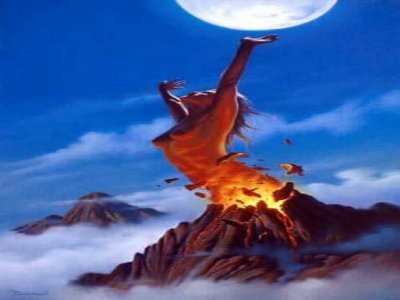
|
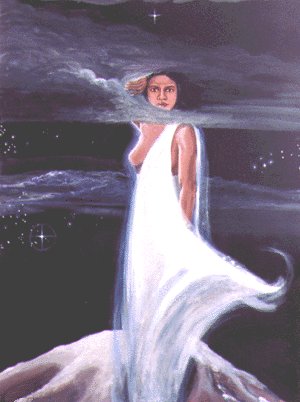 |
Pele's greatest rival was Poliahu, the goddess of
snow-capped mountains. Poliahu was the Ice Queen, a beauty who, like
Pele, seduced handsome mortal chiefs.
Pele's jealousy flamed after she had a fling with a fickle young
Maui chief named 'Ai-wohi-ku-pua, as he was traveling to the Big
Island to court a mortal female chiefain named Laie (surely there is a pun
here just begging to be used). Paddling along the Hana Coast,
'Ai-wohi-ku-pua saw Pele in human form as a beauty named
Hina-i-ka-malama, riding the surf. He paused for a brief
affair.
Then he went on to the Big Island, where Poliahu seduced him. He
convinced his personal goddess to release him from his promise to
his first love, and went back to Kaua'i with the snow goddess.
Pele (disguised as Hina-i-ka-malama) chased after them, eventually
winning back the fickle chief by seducing him on Mount
Kamana-eye-wanna-Laie-a.
However Poliahu was so vindictive, she blasted the lovers with cold
and heat until they separated. In the end, 'Ai-wohi-ku-pua was left with no
lover at all.
As I read these tales, I was reminded of Zeus from Greek Mythology.
I always thought Zeus held the record for randy behavior, but these
wild Hawaiian goddesses were pretty bawdy in their own right.
|
|
|
THE HOTSPOT
THEORY
|
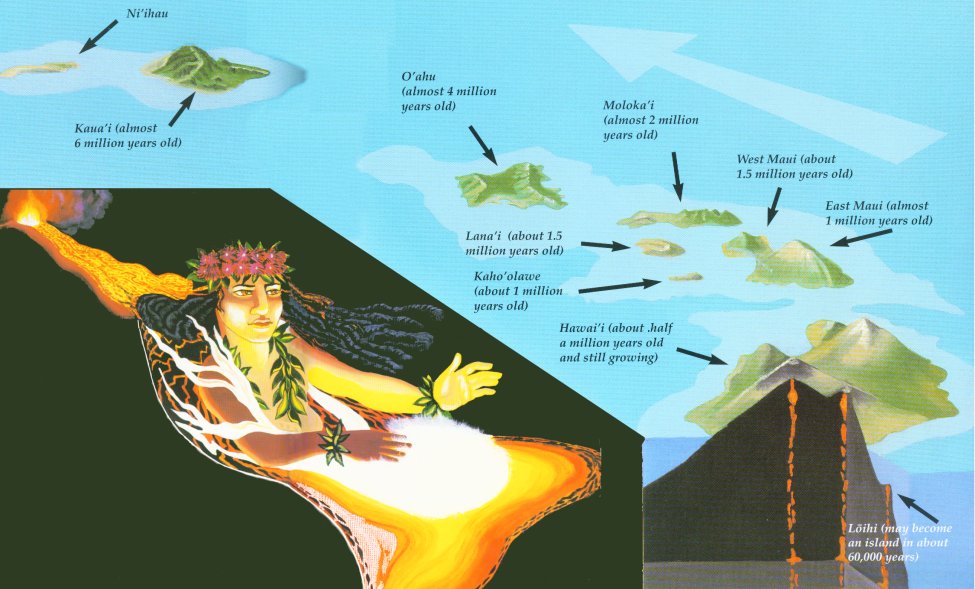 |
If you prefer the scientific explanation for
the formation of the Hawaiian Islands over Pele and the mythological
explanations, you have to start with the Hot Spot Theory.
First you have to understand there is an enormous Pacific Plate that
is nearly the size of the Pacific Ocean. This enormous rock
plate constantly drifts towards the northwest. In the very
center of the Pacific Plate exists a fixed "Hot Spot" where magma
(lava) from the earth's core is trying to release pressure through a
volcanic opening on the surface. Besides the Hawaiian Hot
Spot, there are about 100 hot spots spread around Earth including an
ominous one in Yellowstone Park (Old Faithful is a manifestation).
Once upon a time, Kauai, the oldest of the island chain, was
directly over the Hot Spot. Lava spewing through a volcano
created Kauai. However as the Pacific Plate slowly drifted to
the northwest, Kauai was dragged away from the Hot Spot and ceased
to grow.
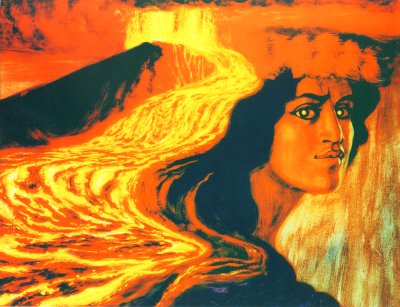 |
Today Kauai is the most rugged island for a good
reason. As the oldest island, Kauai has experienced 6 millions
year of erosion. Spectacular attractions on Kauai
like the Napali Coastline, Waimea Canyon and the Kalalau Valley
are marvelous testaments to nature's power. Kauai is
also the most heavily forested island because nature has had more
time to break down the lava and create forests.
When I compared the natural beauty of Kauai to the Big Island,
there was no contest. Kauai had stunning beauty while the
landscape of the Big Island was relatively ho-hum by comparison. Who said
some things don't get prettier with age?
Oh, by the way, did I mention the rate at which the Pacific
Plate approaches Japan? 1 to 4 inches a year.
Rome wasn't built in a day and apparently neither were the
Hawaiian Islands.
|
|
After Kauai inched its way off the Hot Spot, two million years later the
Hot Spot created
Oahu.
Then one and a half million years ago the Hot Spot
created four sister islands - Maui, Lanai, Molokai, and a little known
island known as Kaho'olawe.
Slowly but surely these islands
drifted away as well, creating the opportunity for the Big Island to be
formed just a short half million years ago.
At first Mauna Kea rested over the Hot Spot. As the new island
drifted, a new volcano named Mauna Loa became centered over the Hot
Spot. Currently it is Kilauea that is over the Hot Spot.
Now you see why the Big Island
is the biggest - it is the New Kid on the
Block. In addition, since Mauna Loa and Kīlauea are active
volcanoes, the Big Island is
growing as I write. Between
January 1983 and September 2007,
600
acres of land were added to the island by
lava flows from Kīlauea volcano which
extended the coastline
outward.
Believe it or not, the next great Hawaiian
Island is already forming as we speak. It even has a name! Loihi is expected to
break the water surface in just 60,000 years.
I will keep you
posted on any developments. Marla is currently investigating
cruise opportunities to Loihi.
|
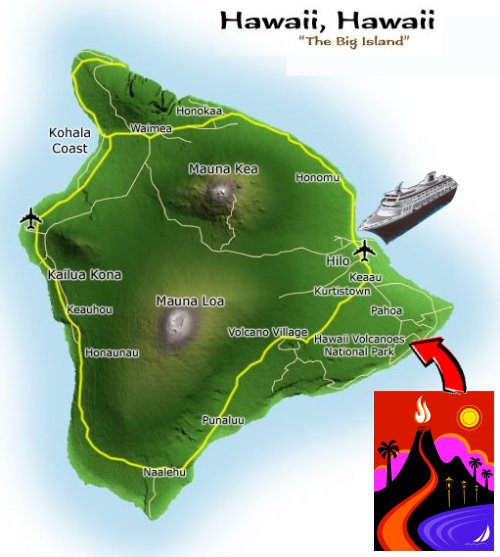 |
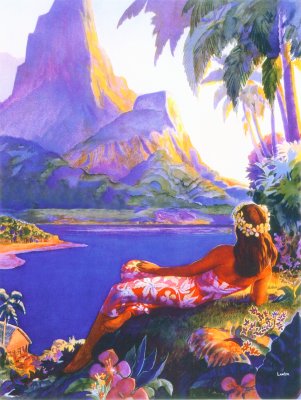 |
The ancient Hawaiians suspected
that the Islands became younger to
the southeast. During their
voyages, sea-faring Hawaiians noticed the differences in
erosion, soil formation, and vegetation.
They recognized that
the islands to the northwest (Niihau and Kauai) were
much older
than those to the southeast (Maui and Hawaii).
Unable to grasp any sensible reason for this
development, the Hawaiians turned to our girlfriend Pele and
blamed it all on her. According to legend,
Pele, the fiery Goddess of Volcanoes,
originally lived on Kauai. When
her older sister Namakaokahai, the Goddess of the Sea,
attacked her, Pele fled to the Island of Oahu.
When she was forced by
Namakaokahai to flee again, Pele moved southeast to Maui and
finally to Hawaii, aka the Big Island.
The mythical flight of Pele from Kauai to Hawaii,
which alludes to the eternal struggle between the growth of
volcanic islands from eruptions and their later erosion by
ocean waves, is consistent with geologic evidence obtained
centuries later that clearly shows the islands becoming
younger from northwest to southeast.
Currently Pele is said to live in the Halemaumau
Crater at the summit of Kilauea Volcano. Pele this, Pele that. Every myth starts with
Pele. Personally, I have my own theory why Pele is the
favorite goddess. The way I see it, she is the only
goddess with a name people can spell or pronounce (see 'Namakaokahai').
As it stands, Pele has not moved in over a million years.
A little bored with her current digs over in Kilauea
Volcano, rumor has it that she
briefly took up soccer in Brazil.
|
|
STUPID
IGNORANT TOURISTS
|
 |
Now that I have become an experienced
traveler thanks to the much-appreciated efforts of my gifted
wife Marla, I suppose I have also become something of a
travel snob.
I admit I absolutely hate stupid tourists. I
can forgive people who are inexperienced, but at least make an effort
to figure things out. It is the people who don't pay
attention that get under my skin.
They are usually pretty easy to spot - they wear the loudest
outfits, they make the most noise, they love to brag about
all the things they know, and they act as if the world
revolves around them at all times.
After these obvious signs, the next characteristic to look
for is a lack of patience and the inability to listen to
instructions.
For some reason, these know-it-all types don't pay a bit of
attention and their ignorance usually ends up slowing down
the group as a result or inconveniencing other people in some way.
Since most group efforts depend on a uniform performance by
all members, one obnoxious person can ruin the entire day.
I absolutely can't stand stupid tourists!
Hang on to this thought. I will come back to it later.
|
|
Day Two of the SSQQ Cruise Trip brought our
group to the Big Island. Marla suggested we take an excursion
to visit the area known as Hawaii Volcanoes National Park.
Fascinated by
volcanoes, I was definitely in agreement.
Marla and I had signed up for a tour and got some maniac as our tour
guide. Calling himself 'Bird', short for 'Jailbird', our bus
driver/tour guide claimed to be out on day parole from prison.
Bird picked us up in his van near the dock in Hilo. He
immediately told us we could not take his picture because it would
violate his parole agreement. When he wasn't looking, I took
one anyway. Society needs to be warned.
As an experienced traveler, I have to tell you that Bird had the
most unusual shtick for a tour guide I have ever run across.
He had me alternating between convulsive laughter and a deep suspicion
there might be an element of truth to his story.
I can be a bit of a nut myself. When Bird told us he was
taking writing lessons in prison, I suggested he write a plot for
breaking out of jail using an ancient lava tube as an escape route.
Bird was so genuinely impressed by that idea, he thanked me
profusely. He said there was a lava tube near the prison that a
short tunnel should be able to reach. I was afraid to ask if
he was thanking me for the wrong reasons.
We were headed near the Kilauea
Volcano, which has been erupting on a daily basis since
1983. I asked Mr. Jailbird why it was safe to visit a
live volcano. I mean, aren't volcanoes something to be
feared? Jailbird explained that the pressure at Kilauea is constantly
being released, so there is no build-up of the kind of
pressure that makes a volcano go kaboom like Dante's Peak. Later on I took a photograph of a
sign that helped explain what he was talking about.
|
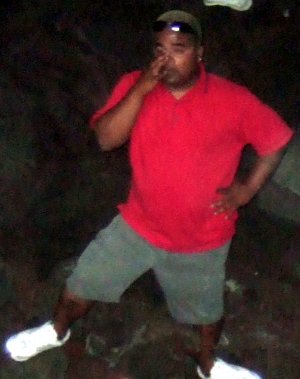 |
|
|
 |
|
x |
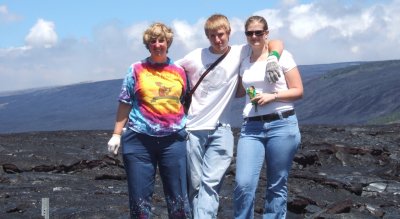 |
To pass the time as we drove to the
lava fields, Bird suggested we introduce one another.
Marla and I discovered the family sitting behind us lived
about four blocks away from us here in the Houston Heights. I
have passed their house during 'Lights in the Heights'
several times.
In fact, the mother said her sister Stephanie Shapiro
met her husband Chuck right here at the studio back in the
Nineties and got married. I knew exactly who she was
talking about.
Chuck
and Stephanie were a big part of the studio back in
those days. Small world, isn't it?
And yes, please don't ask, I don't have a clue what
their names are. But I can point to their house.
|
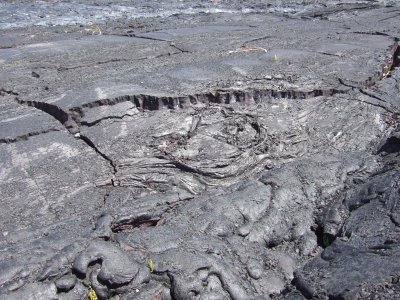 |
Once we got to the lava fields, the
road ended. I have to tell you that I was stunned by
the barren landscape. As far as my eye could see, the
land was covered by dried lava. There were miles
and miles of grey-black lava devastation. The landscape was
both ugly and amazing. I was totally stunned. I
felt like I was visiting a bomb blast area.
There was a bumpy path of sorts carved out in the lava fields for
our minibus to travel over. I soon realized this area
had once been very expensive real estate. Now
everywhere I looked there was devastation.
Although it is Kilauea that is currently moving towards the
Hot Spot, Mauna Loa still has some fight in it.
The
old veteran Mauna Loa sprang back into life in 1984. Everything in the path of
its
lava flow was flattened - homes, roads, rain forests.
This was not a one-time event either. Several
towns have been destroyed by Mauna Loa lava flows: Kapoho (1960),
Kalapana (1990), and
Kaimū (1990).
Over
the past twenty years, total losses
of property have exceeded $61
million, making this ongoing eruption the most costly in
Hawaiian history.
|
|
Warning - Live Volcano in action! |
|
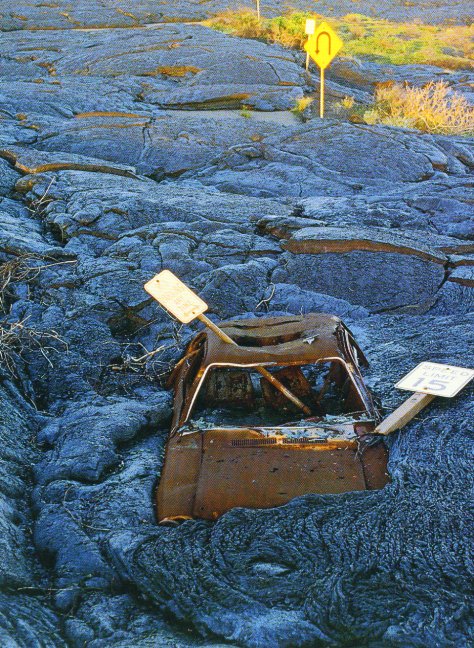 |
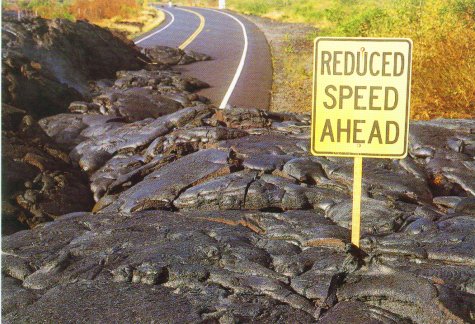
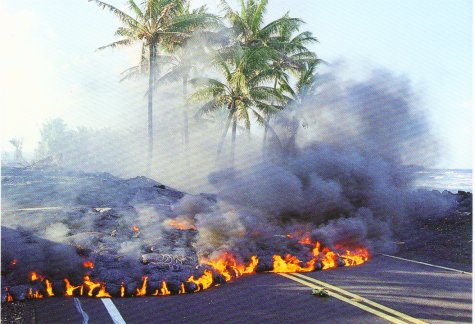 |
| |
|
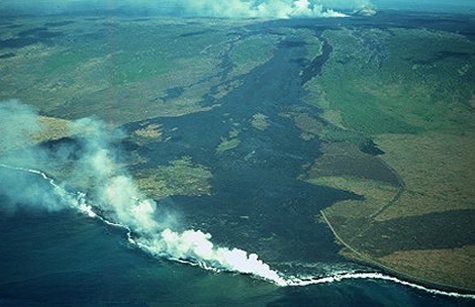
The green areas are forests, the dark area is lava.
Do you see how the beach curves? The lava is extending the shore
line.
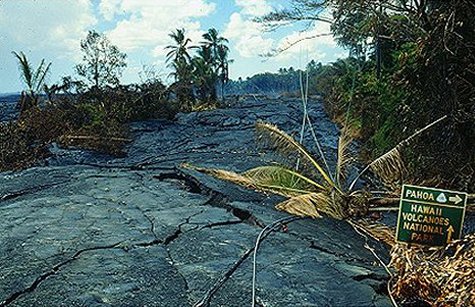
Fortunately these eruptions are so
tame there has been
virtually no loss of life. People just get out of the way. |

Over the years, 182 homes were
destroyed including
the entire high-end Kalapana Gardens Subdivision
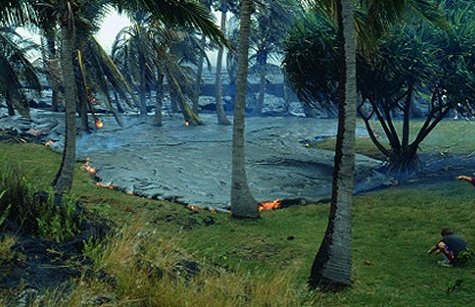
Indeed, small
children are allowed to sit and watch as the lava approaches.
|
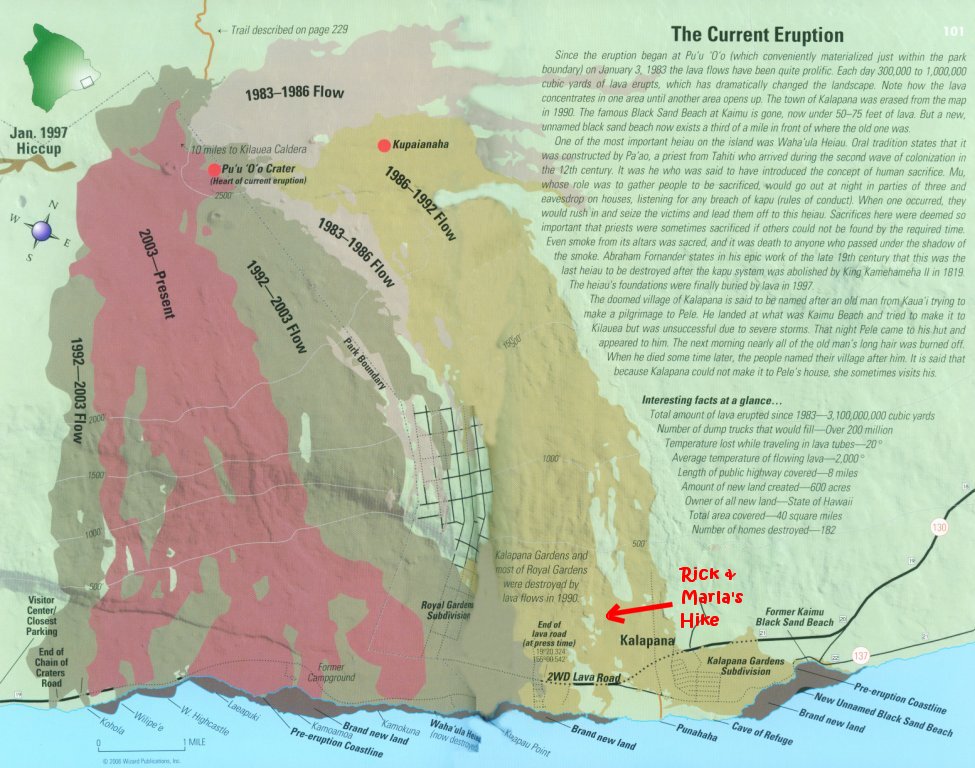
I am not positive, but I believe our hike took
place in the former Kalapana Gardens. For one thing, the Pacific Ocean
was only about half a mile away. I remember the highway abruptly
ending (#130 in map above) so we had to drive on a terribly bumpy road for a couple
hundred yards. Then the paved highway returned. That description is
consistent with
the map above where the road heads into Kalapana.
When the paved road ended a second time, our bus continued another half mile heading west
over a very rugged road.
From there we got out of the bus and started to walk. Our hike took us even
further west.
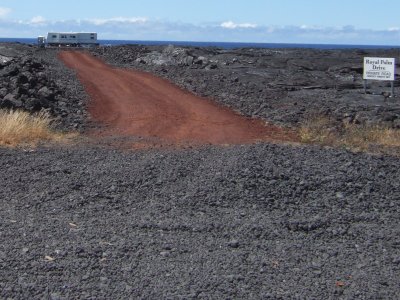 |
Since Jailbird broke every speed law imaginable,
we were the first ones there. I had been told we were going to
see brand new lava emanating from the earth. That thought had
me seriously pumped. Let's get it started!
Imagine how frustrated I was when they told me we had to wait
until every single bus showed up. Now that we were finally
here, I wanted to see some actual lava. Never the most patient
of people, I was chomping at the bit to get the show on the road.
I took a couple pictures to deal with the boredom. Someone
actually lives in that trailer home. His sign says "Royal
Palms Drive. Intruders Keep Out". Oh boy, such an
estate! Can't wait to rob that place!
I was going nuts waiting for those other buses to arrive.
Finally I gave up, went back to my bus, sat down and started to play
computer chess to pass the time. It was the only way I could handle
the wait.
|
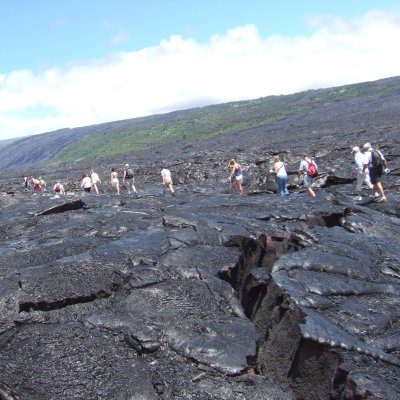 |
It took over half an hour for the other buses
to arrive. When they did arrive, it took even longer to
organize everyone. There were well over 100 people. I
could see they were having some sort of meeting, but I was on the
verge of winning my chess game and paid it no attention.
Finally Marla came and got me. I finished my chess game and
sprang back into action. I counted 12 buses. Each bus
carried ten people.
Hmm. 12 buses
carrying 10 people per bus. Since our fee was $100, some quick
math told me today's gate was a cool $12,000. Here I thought I
was the greatest huckster of all time. Who else could get
people to pay hard-earned money to learn "The Monster Mash"?
But I had obviously met my match. These people were paying
$100 a pop to see the ugliest terrain on the planet. Now
that's impressive! Someone was a marketing genius. These lava tours
were good business!
They herded us up like cattle and demanded we walk single
file. Furthermore they insisted we not take any pictures.
No reasons were given. I didn't care. I took pictures
whenever I wanted.
|
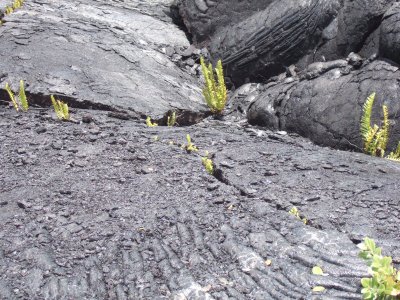 |
As we walked, I was fascinated to see plant
life trying to re-establish itself in this barren wilderness. It
could not have been easy. There could not have been much in
the way of nutrients in that lava. Nor was there any soil to
absorb and retain rain water. I imagine rainwater disappeared
quickly into those cracks.
Furthermore the heat was brutal. With all this heat, I was very impressed by these little
sword ferns making a serious first step towards reforesting this
area.
Lava is made from
basalt. 50% of basalt is silica, a glass-like substance.
In other words, the entire lava field was one giant mirror radiating
sun light in every direction.
Too bad I didn't know this fact ahead of time. Despite wearing
a hat and putting on lotion, my
face and neck still became badly sunburned thanks to the constant reflections
off the lava surface.
|
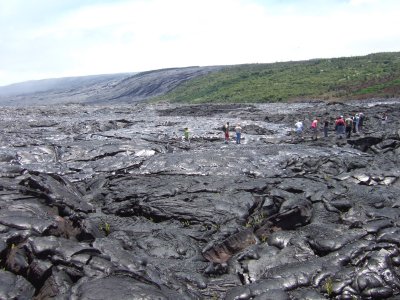 |
As you can see, the destruction stretched for
miles. This picture should give you an idea just how brutal the lava
flow was. Here you can see some of the forested area that was
spared. This was one of the few patches of greenery that the
lava had missed.
Mind you, there had been thick forests here as recently as 10
years ago. Not any more. The lava flow had flattened
everything in sight.
The lava field went on and on as far as the eye could see. I
felt like we were walking on the moon.
As the hike moved into its second hour, the line stretched further
apart as the slowest buffaloes brought up the rear. As we
continued to walk single file, we were flanked on either side by our
guides. They were determined to keep us in line.
The guides all had very serious expressions on their faces.
Furthermore they refused to be engaged in conversation. I was
very curious what this was all about.
|
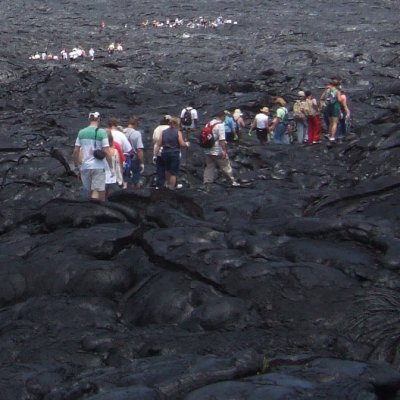 |
We must have walked three miles. Our
group was stretched a mile apart. I could
not even see our bus anymore. I kept wondering when we would
get to the lava flow. To be honest, I had no idea what it was
we were looking for. I guessed it was some sort of lava pit we
could stare down into. I also kept wondering where the signs were.
There was absolutely no discernible trail. We just followed
the leader.
I noticed several guides had separated from the group and
were walking around in
different directions. They seemed to be looking for
something. The other guides told to stop moving and wait for
them.
I finally got a guide to talk to me. Why were there no markers
and no trail? She said they had no idea where the lava was.
She said the lava appeared in different places every day. She
said they would walk around till they found what they were looking
for.
I didn't expect that answer. Like I said, I assumed we were going to some sort of
pre-determined lava pool. Why not just mark where it is?
Put a flag near it or an orange traffic cone. How hard would
that be?
I remember at the time
feeling bored out of my wits. I was just walking around la-di-da
waiting for the daily eruption show. What time does the
volcano usually start its day?
|
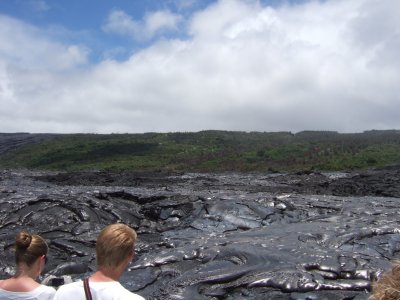 |
I have a question for you. Study this
picture and the one above for a moment. Do you see
anything different in this picture compared to one directly above? I will make my point
in a second.
I kept plodding around looking for something interesting to
look at. This lava field had begun to look all the same wherever I
went.
Then about one hundred yards away I noticed a flurry of
activity. People began to gather in a spot. Finally!
I immediately began to run over to the Hot Spot.
Suddenly my guide
screamed at me to stop.
There was something in her voice that
made me decide she must know something I didn't, so I stopped.
The woman came over to me and pointed down at my feet.
I was standing just three feet from a lava flow that would have
taken my entire foot off in seconds! And I am not
kidding either.
|
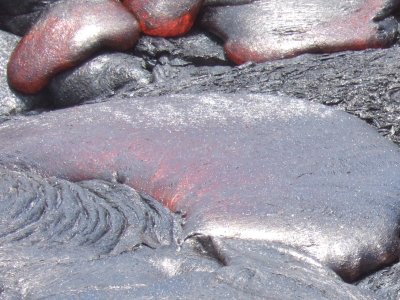 |
It turns out there are three shades of lava -
dark grey, silver grey, and burning grey lava that mixes silver and red.
Dark grey is safe, but not the light silvery grey that I had almost
stepped on. This silver lava seemed to have cooled, but in reality
it was nearly as hot as the red
lava.
In the picture above, you can see the shiny silver lava.
That stuff would have taken my feet off in seconds! Time for
the Texas Hop Hop Hop.
And I had no idea of the danger I was walking into.
Badly shaken, I
started tip-toeing my way around very carefully. I did not
take one step without first inspecting where I was headed for signs of
danger.
I felt like I was caught in a minefield!
Slowly I got a grip
and studied the lava around me. Now that I had been warned, I
quickly learned the difference between the safe dark grey lava that was cool
and the dangerous silver stuff that lurked everywhere.
|
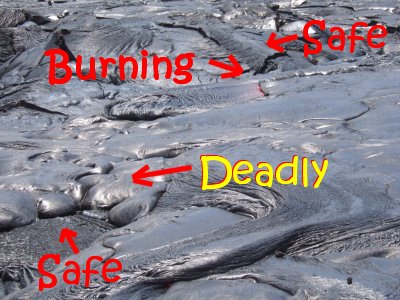 |
Once I knew what to look for, first came
relief, but then I began to feel angry. Okay, yes, my guide
had done her job and made sure I didn't do anything stupid.
Good for her.
But why didn't anyone bother to explain the danger ahead of time?
Why all the secrecy?
I now understood the single file. By flanking us on either
side, the guides made sure we didn't accidentally wander into fresh
lava.
But it would not have been difficult to simply tell people there
were potential dangers in the area we were heading to and show
photographs of what to look out for. Just tell us, for crying
out loud!
If someone really did get hurt, these people had left themselves
wide open for a negligence claim.
|
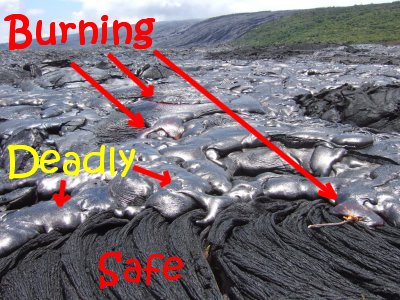 |
I have a favorite saying: Experience is
a comb Life throws you after you have lost all your hair.
I could easily see people who had no idea of the danger coming to
this location on their own only to lose a foot. This lava was
a real threat!
That's why I admire test pilots and pioneers. They have the
guts to be the first to try things out before anyone knows what the
dangers are. You can always spot the pioneers - they are the
ones lying in the trail with arrows in their backs.
A good example of learning things the hard way is Madame Curie.
She is one of my all-time heroes. Madame Curie did amazing
work in the new field of radioactivity, winning two Nobel Prizes
along the way. However Madame Curie also made a deeply
unpleasant discovery during her work
with radioactivity - she died from radiation poisoning!
|
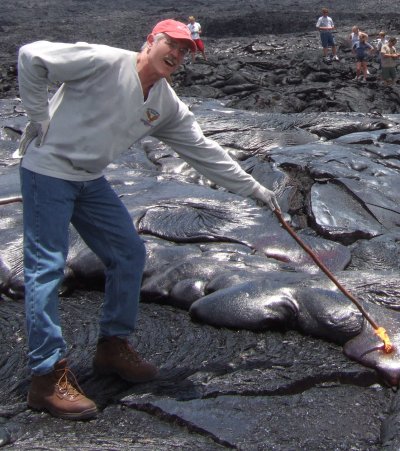 |
Back when I was kid, I
put my left eye out with a knife. I was cutting on some rope
in the wrong direction. That's another good example of
learning things the hard way. I am permanently blind in my
left eye. This serves as a constant reminder to cut things
correctly.
My brush with the camouflaged lava was a pretty close call.
I had come within three feet of becoming a one-legged
dance instructor. I was definitely shaken. And I
was angry too. No
wonder I was so angry! I had no idea this trip was so
dangerous... because I didn't pay attention. But I wasn't even
aware that it was my fault.
As we walked back to the bus, I complained to Marla about the
stupidity of the guides not to warn us ahead of time about the
silver lava.
Marla gave me a funny look. "They warned us plenty."
I looked at her. "You're kidding. When?"
"Once everyone arrived, they had a big meeting while you
stayed on the bus playing computer chess. I thought you were listening."
My mouth dropped open in shock.
Although
I love to make fun of stupid tourists, let me
assure you it wasn't nearly as much fun to discover this time the
ignorant tourist was me.
I didn't say much for the rest of the afternoon.
I was ashamed of myself.
|
|